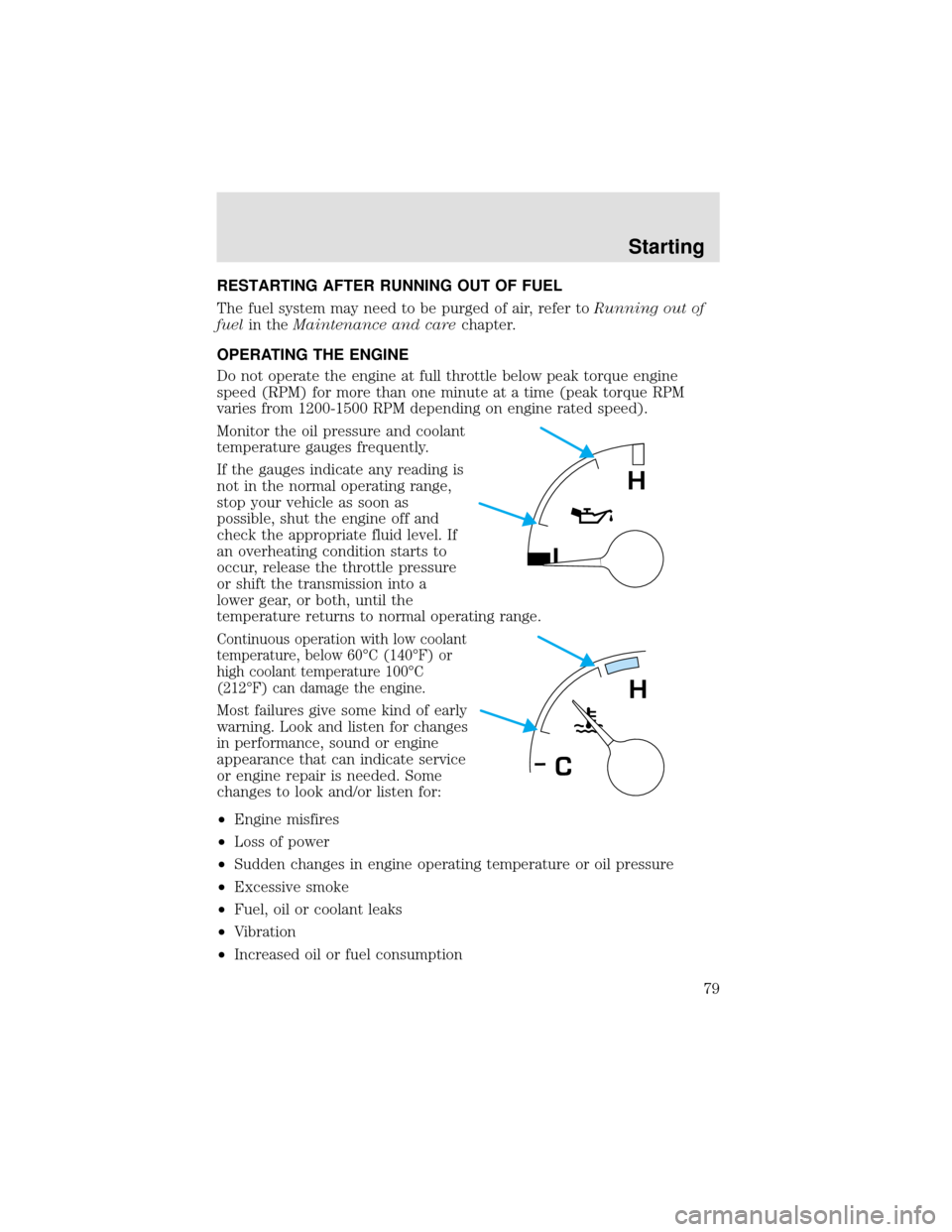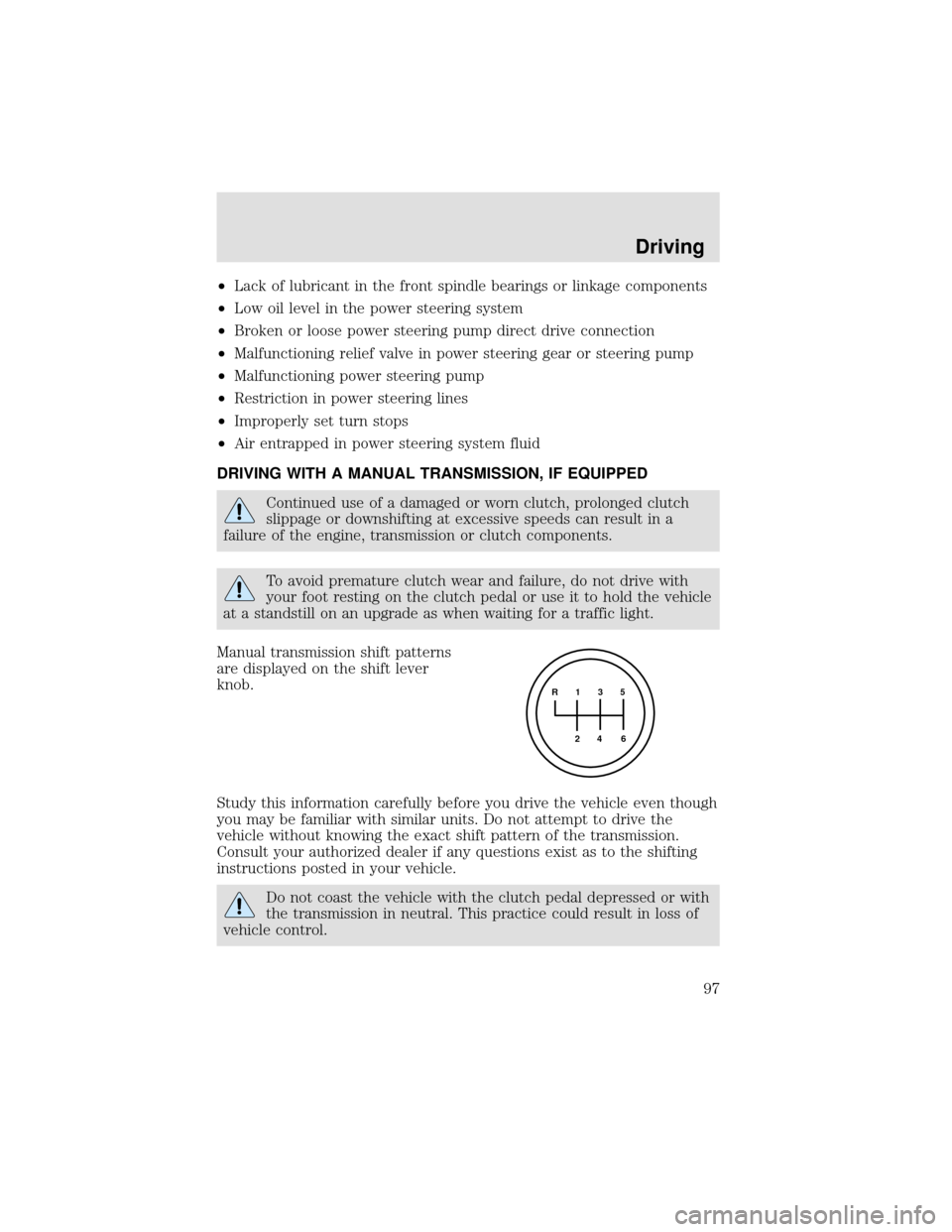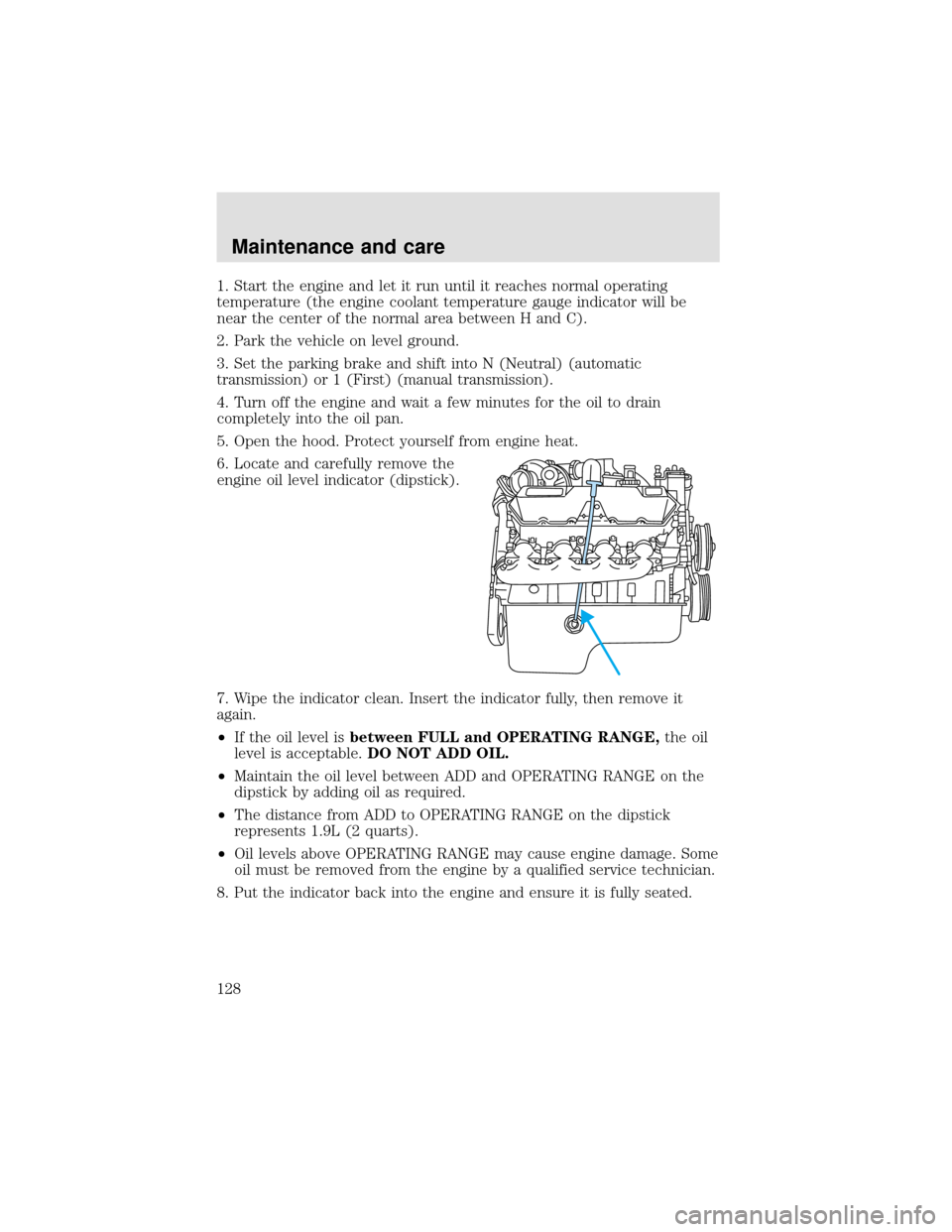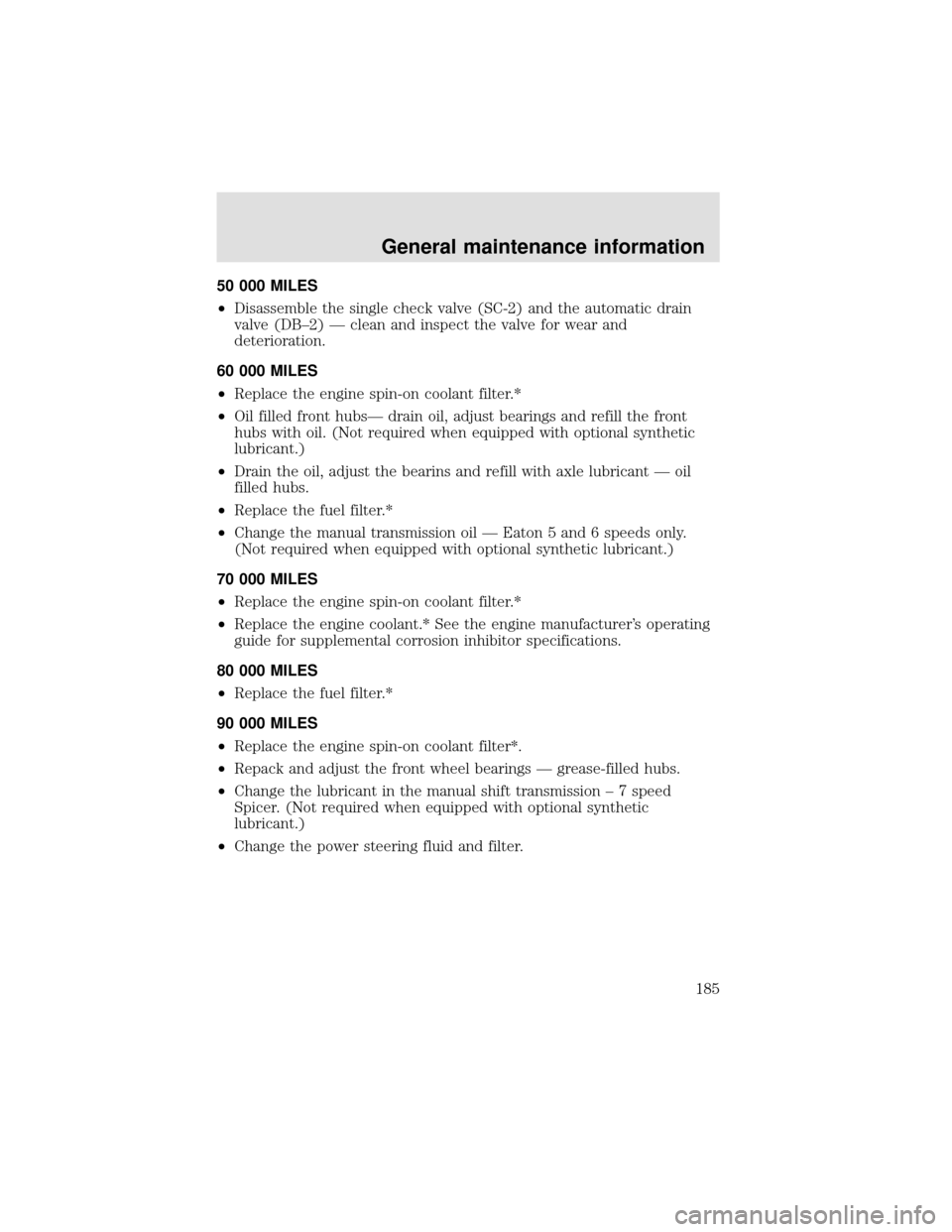transmission oil FORD F650 2000 10.G Owners Manual
[x] Cancel search | Manufacturer: FORD, Model Year: 2000, Model line: F650, Model: FORD F650 2000 10.GPages: 208, PDF Size: 1.08 MB
Page 79 of 208

RESTARTING AFTER RUNNING OUT OF FUEL
The fuel system may need to be purged of air, refer toRunning out of
fuelin theMaintenance and carechapter.
OPERATING THE ENGINE
Do not operate the engine at full throttle below peak torque engine
speed (RPM) for more than one minute at a time (peak torque RPM
varies from 1200-1500 RPM depending on engine rated speed).
Monitor the oil pressure and coolant
temperature gauges frequently.
If the gauges indicate any reading is
not in the normal operating range,
stop your vehicle as soon as
possible, shut the engine off and
check the appropriate fluid level. If
an overheating condition starts to
occur, release the throttle pressure
or shift the transmission into a
lower gear, or both, until the
temperature returns to normal operating range.
Continuous operation with low coolant
temperature, below 60°C (140°F) or
high coolant temperature 100°C
(212°F) can damage the engine.
Most failures give some kind of early
warning. Look and listen for changes
in performance, sound or engine
appearance that can indicate service
or engine repair is needed. Some
changes to look and/or listen for:
•Engine misfires
•Loss of power
•Sudden changes in engine operating temperature or oil pressure
•Excessive smoke
•Fuel, oil or coolant leaks
•Vibration
•Increased oil or fuel consumption
L
H
H
C
Starting
79
Page 97 of 208

•Lack of lubricant in the front spindle bearings or linkage components
•Low oil level in the power steering system
•Broken or loose power steering pump direct drive connection
•Malfunctioning relief valve in power steering gear or steering pump
•Malfunctioning power steering pump
•Restriction in power steering lines
•Improperly set turn stops
•Air entrapped in power steering system fluid
DRIVING WITH A MANUAL TRANSMISSION, IF EQUIPPED
Continued use of a damaged or worn clutch, prolonged clutch
slippage or downshifting at excessive speeds can result in a
failure of the engine, transmission or clutch components.
To avoid premature clutch wear and failure, do not drive with
your foot resting on the clutch pedal or use it to hold the vehicle
at a standstill on an upgrade as when waiting for a traffic light.
Manual transmission shift patterns
are displayed on the shift lever
knob.
Study this information carefully before you drive the vehicle even though
you may be familiar with similar units. Do not attempt to drive the
vehicle without knowing the exact shift pattern of the transmission.
Consult your authorized dealer if any questions exist as to the shifting
instructions posted in your vehicle.
Do not coast the vehicle with the clutch pedal depressed or with
the transmission in neutral. This practice could result in loss of
vehicle control.
R 1 3 5
4
6 2
Driving
97
Page 128 of 208

1. Start the engine and let it run until it reaches normal operating
temperature (the engine coolant temperature gauge indicator will be
near the center of the normal area between H and C).
2. Park the vehicle on level ground.
3. Set the parking brake and shift into N (Neutral) (automatic
transmission) or 1 (First) (manual transmission).
4. Turn off the engine and wait a few minutes for the oil to drain
completely into the oil pan.
5. Open the hood. Protect yourself from engine heat.
6. Locate and carefully remove the
engine oil level indicator (dipstick).
7. Wipe the indicator clean. Insert the indicator fully, then remove it
again.
•If the oil level isbetween FULL and OPERATING RANGE,the oil
level is acceptable.DO NOT ADD OIL.
•Maintain the oil level between ADD and OPERATING RANGE on the
dipstick by adding oil as required.
•The distance from ADD to OPERATING RANGE on the dipstick
represents 1.9L (2 quarts).
•Oil levels above OPERATING RANGE may cause engine damage. Some
oil must be removed from the engine by a qualified service technician.
8. Put the indicator back into the engine and ensure it is fully seated.
Maintenance and care
128
Page 168 of 208

ENGINE COOLANT AND OIL REFILL CAPACITIES
Engine Engine coolant
(approximate
capacity)Engine oil
(approximate
capacity)
Caterpillar 3126 B 26.9L (28.4 quarts)
1
Cummins B 5.9L 23.1L (24.4 quarts)1
Power Stroke 7.3L 25.1L (26.5 quarts) 18.0L (19.0 quarts)2
1
Refer to the engine operator’s manual for engine oil refill capacities.
2Engine oil and filter change.
POWER STEERING FLUID CAPACITIES
GVWR Axle application System capacity
11 794/13 608 kg (26
000/30 000 lb.)3 856/4 082 kg (8
000/9 000 lb.)4.3L (4.5 quarts)
14 969 kg (33 000 lb.) 5 443 kg (12 000 lb.) 4.5L (4.7 quarts)
TRANSMISSION REFILL CAPACITIES
Type and make Approximate capacity
5-speed (Eaton FS-4205A)1, 25.4L (5.75 quarts)
5-speed (Eaton FS-5205A)1, 25.9L (6.25 quarts)
6-speed (Eaton FS-5306A and
FS-6306A)
1, 29.2L (9.75 quarts)
7-speed (Spicer ES52-7B and
ES066-7B)
1, 210.4L (11.0 quarts)
Allison AT-545
318.9L (20.0 quarts)
2000/2400 Series-Standard sump 10.0L (10.6 quarts)4
2000/2400 Series-Shallow sump 7.0L (7.4 quarts)5
MD series327.4L (29.0 quarts)
1Quantity shown is nominal; fluid level should be at lower edge of fill
hole.
2Fill plug is located on the right side of the transmission and the drain
plug on the rear of the transmission.
3Fluid level should be checked by your dealer or a qualified service
technician.
Capacities and specifications
168
Page 171 of 208

Item Ford Part NameFord Part
NumberFord
Specification
Spring leaves,
transmission
linkage pivots,
brake and clutch
pedal pivots and
clevises,
transmatic
detent stop,
starter motor.Motorcraft SAE
10W30 Super
Duty Motor OilXO-10W30-QSD WSS-
M2C171-B
Automatic
transmissionRefer to the Allison Automatic Transmission
Operator’s manual.
Rear axle and
front wheel
bearings (oil
filled)
1
SAE 80W-90
Premium Rear
Axle LubricantXY-80W90-QL WSP-
M2C197-A
SAE 75W-140
High Performance
Rear Axle
Lubricant
(synthetic)F1TZ-19580-B WSL-
M2C192-A
Manual
transmission
1Motor oil SAE 50
(above -18°C
[0°F])2N/A
Motorcraft SAE 30
Super Duty Motor
oil (below -18°C
[0°F])XO-30-QSD
3WSS-
M2C171-B
Engine oil-
7.3L Power
Stroke engine
1, 4
Motorcraft Super
Duty Motor oilXO-15W40-
QSD3
XO-10W30-
QSD3
WSS-
M2C171-B
Motorcraft SAE
0W-30 Super All
Season Motor oil
(synthetic)XO-0W30-LAS
Engine oil-
Cummins B and
Caterpillar 3126
B enginesRefer to the appropriate engine operator’s manual.
Capacities and specifications
171
Page 179 of 208

SCHEDULED MAINTENANCE SERVICES
Maintenance service adjustments must conform to specifications
contained in this manual, and those shown on the Important Engine
Information Decal. The following services are to be performed at
scheduled intervals because they are considered essential to the life and
performance of your vehicle. Ford recommends that you perform
maintenance on all designated items to achieve best vehicle operation.
Scheduled maintenance beyond 160 930 km (100 000 miles) should be
continued as before 160 930 km (100 000 miles).
SPECIAL OPERATING CONDITIONS
If your driving habitsfrequentlyinclude one or more the following
conditions:
•Short trips oflessthan 16 km (ten miles) when outside temperatures
remain below freezing.
•Operating duringhot weatherin stop-and-go“rush hour”traffic.
•Operating in severe dust conditions.
•Extensive idling, or low speed operation such as door-to-door delivery
service.
•High speed operation with a fully loaded vehicle (max. GVW).
•Snowplowing.
Perform the following:
•Change engine oil and oil filter every three months, 8 000 km (5 000
miles) or 125 hours of engine service.
•If operating in severe dust conditions, replace the air cleaner filter
more often than regular intervals as determined by the air filter
restriction indicator. Make sure that the air filter restriction indicator
is in good working order.
•Lube the manual transmission and the rear axle every 48 279 km
(30 000 miles) or 6 months, whichever comes first.
•See the Allison, Cummins and Caterpillar Operator’s Manual.
General maintenance information
179
Page 182 of 208

Daily Owner Checks Engine system
Check the air filter restriction indicator
Check the engine oil
Inspect the coolant level - for Powerstroke
engine (for Caterpillar and Cummins engines,
refer to the Owner’s Manual)
Brake system
Drain the air brake system reservoir - manual
valve
Check the air brake system reservoir automatic
drain valve operation
Transmission system
Visually check the automatic transmission for
fluid leakage
Steering system
Check the power steering pump fluid level and
check the system for leaks
Check the entire vehicle for evidence of fluid
leaks
U.S. Department of Transportation,
Federal Highway Administration
requirements (ensure that the entire
system is functioning properly)
Check the service brakes
Check the parking brake
Check the steering mechanism
Check the lighting devices and reflectors
Check the tires
Check the horn
Check the windshield wipers
Check the rear vision mirrors
Check the wheels and rims
Check the emergency equipment
General maintenance information
182
Page 184 of 208

Check every oil
changeOil change
intervals are as
follows: Powerstroke -
10 000 ; Caterpillar -
10 000 ; Cummins -
15 000 (refer to the
Caterpillar and
Cummins service
manuals for further
instructions and
information)Steering system
Lubricate the steering shaft(s), U-joints and
splines when equipped with grease fittings
Lubricate the front axle spindle pins
Lubricate the steering linkage when equipped
with grease fittings
Grease the power steering gear output shaft
* Coolant protection checks should be made just prior to the onset of
freezing weather, where applicable. If coolant is dirty or rusty in
appearance, the system should be drained, flushed and refilled with the
prescribed solution of cooling system fluid and water. Use only
permanent type coolant that meets Ford specifications ESE-M97B18-C.
See the engine manufacturer’s operating guide for supplimental
corrosion inhibitor specifications.
In addition to the items to be performed daily or at each oil change, the
following need to be completed as specified:
5 000 MILES
•Initial change—change the lubricant in the manual shift transmission
–5 speed and 6 speed Eaton manual transmission. (Not required
when equipped with optional synthetic lubricant.)
20 000 MILES
•Replace the fuel filter.*
30 000 MILES
•Replace the engine spin-on coolant filter.*
•Repack and adjust the front wheel bearings—grease-filled hubs.
40 000 MILES
•Replace the fuel filter.*
General maintenance information
184
Page 185 of 208

50 000 MILES
•Disassemble the single check valve (SC-2) and the automatic drain
valve (DB–2)—clean and inspect the valve for wear and
deterioration.
60 000 MILES
•Replace the engine spin-on coolant filter.*
•Oil filled front hubs—drain oil, adjust bearings and refill the front
hubs with oil. (Not required when equipped with optional synthetic
lubricant.)
•Drain the oil, adjust the bearins and refill with axle lubricant—oil
filled hubs.
•Replace the fuel filter.*
•Change the manual transmission oil—Eaton 5 and 6 speeds only.
(Not required when equipped with optional synthetic lubricant.)
70 000 MILES
•Replace the engine spin-on coolant filter.*
•Replace the engine coolant.* See the engine manufacturer’s operating
guide for supplemental corrosion inhibitor specifications.
80 000 MILES
•Replace the fuel filter.*
90 000 MILES
•Replace the engine spin-on coolant filter*.
•Repack and adjust the front wheel bearings—grease-filled hubs.
•Change the lubricant in the manual shift transmission–7 speed
Spicer. (Not required when equipped with optional synthetic
lubricant.)
•Change the power steering fluid and filter.
General maintenance information
185
Page 205 of 208

Air cleaner filter .......................142
Air conditioning ..........................21
Audio system (see Radio) .........26
Automatic transmission ............102
Auxiliary power point .................21
Battery .......................................140
jumping a disabled battery ....125
voltage gauge ............................18
Belt minder .................................67
Brakes ................................82,84,87
anti-lock ......................82,83,84,90
anti-lock brake system
(ABS) warning light ............12,83
brake warning light .............10,11
fluid, checking and adding ....131
parking ............................85,87,90
trailer .........................................93
Child safety restraints ................71
child safety belts ......................71
Child safety seats ...................72,73
attaching with tether straps ....75
in front seat ..............................74
in rear seat ................................74
tether anchorage hardware .....76
Cleaning your vehicle ...............164
engine compartment ..............165
exterior ....................................165
exterior lamps .........................166
instrument panel ....................166
instrument panel lens ............167
interior .....................................167
plastic parts ............................166
safety belts ..............................167
washing ....................................164
waxing .....................................164
wheels ......................................165
wiper blades ............................166
Climate control (see Air
conditioning or Heating) ............21
Clock ..................................29,36,45
Clutch ........................................132
fluid ..........................................132Coolant ......................................134
checking and adding ..............134
Cruise control
(see Speed control) ....................51
Customer Assistance ................114
Ford accessories
for your vehicle ......................201
Ford Extended
Service Plan ............................194
Getting assistance outside
the U.S. and Canada ..............200
Getting roadside assistance ...114
Getting the
service you need ....................194
Ordering additional
owner’s literature ...................203
The Dispute
Settlement Board ...................197
Utilizing the Mediation/
Arbitration Program ...............200
Daytime running lamps
(see Lamps) ................................20
Driving under special
conditions
through water .........................112
Emergencies, roadside
jump-starting ..........................125
Emission control system ..........176
Engine
check engine/
service engine soon light .........14
cleaning ...................................165
coolant .....................................134
Engine block heater ...................80
Engine fan .................................136
Engine oil ..................................127
checking and adding ..............127
oil pressure gauge ....................19
recommendations ...................129
Exhaust fumes ............................81
Fuel ............................................151
Index
205